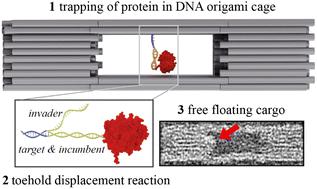Our official English website, www.x-mol.net, welcomes your
feedback! (Note: you will need to create a separate account there.)
Trapping of protein cargo molecules inside DNA origami nanocages
Nanoscale ( IF 5.8 ) Pub Date : 2022-11-22 , DOI: 10.1039/d2nr05356j Merle Scherf 1, 2 , Florian Scheffler 1, 2 , Christopher Maffeo 3 , Ulrich Kemper 2 , Jingjing Ye 2, 4 , Aleksei Aksimentiev 3, 5 , Ralf Seidel 2, 4 , Uta Reibetanz 1
Nanoscale ( IF 5.8 ) Pub Date : 2022-11-22 , DOI: 10.1039/d2nr05356j Merle Scherf 1, 2 , Florian Scheffler 1, 2 , Christopher Maffeo 3 , Ulrich Kemper 2 , Jingjing Ye 2, 4 , Aleksei Aksimentiev 3, 5 , Ralf Seidel 2, 4 , Uta Reibetanz 1
Affiliation

|
The development of the DNA origami technique has directly inspired the idea of using three-dimensional DNA cages for the encapsulation and targeted delivery of drug or cargo molecules. The cages would be filled with molecules that would be released at a site of interest upon cage opening triggered by an external stimulus. Though different cage variants have been developed, efficient loading of DNA cages with freely-diffusing cargo molecules that are not attached to the DNA nanostructure and their efficient retention within the cages has not been presented. Here we address these challenges using DNA origami nanotubes formed by a double-layer of DNA helices that can be sealed with tight DNA lids at their ends. In a first step we attach DNA-conjugated cargo proteins to complementary target strands inside the DNA tubes. After tube sealing, the cargo molecules are released inside the cavity using toehold-mediated strand displacement by externally added invader strands. We show that DNA invaders are rapidly entering the cages through their DNA walls. Retention of ∼70 kDa protein cargo molecules inside the cages was, however, poor. Guided by coarse-grained simulations of the DNA cage dynamics, a tighter sealing of the DNA tubes was developed which greatly reduced the undesired escape of cargo proteins. These improved DNA nanocages allow for efficient encapsulation of medium-sized cargo molecules while remaining accessible to small molecules that can be used to trigger reactions, including a controlled release of the cargo via nanocage opening.
中文翻译:

在 DNA 折纸纳米笼内捕获蛋白质货物分子
DNA 折纸技术的发展直接激发了使用三维 DNA 笼来封装和靶向递送药物或货物分子的想法。笼子将充满分子,这些分子会在外部刺激触发笼子打开时在感兴趣的位置释放。尽管已经开发出不同的笼子变体,但尚未提出使用未附着在 DNA 纳米结构上的自由扩散货物分子有效装载 DNA 笼子以及它们在笼子内的有效保留。在这里,我们使用由双层 DNA 螺旋形成的 DNA 折纸纳米管来应对这些挑战,这些螺旋的末端可以用紧密的 DNA 盖密封。在第一步中,我们将 DNA 结合的货物蛋白附加到 DNA 管内的互补目标链上。封管后,货物分子通过外部添加的入侵者链使用立足点介导的链置换在空腔内释放。我们表明 DNA 入侵者正通过 DNA 壁迅速进入笼子。然而,笼内约 70 kDa 蛋白质货物分子的保留很差。在 DNA 笼动力学的粗粒度模拟的指导下,开发了更紧密的 DNA 管密封,这大大减少了货物蛋白质的意外逃逸。这些改进的 DNA 纳米笼可以有效封装中等大小的货物分子,同时保持可用于触发反应的小分子的可及性,包括货物的受控释放 我们表明 DNA 入侵者正通过 DNA 壁迅速进入笼子。然而,笼内约 70 kDa 蛋白质货物分子的保留很差。在 DNA 笼动力学的粗粒度模拟的指导下,开发了更紧密的 DNA 管密封,这大大减少了货物蛋白质的意外逃逸。这些改进的 DNA 纳米笼可以有效封装中等大小的货物分子,同时保持可用于触发反应的小分子的可及性,包括货物的受控释放 我们表明 DNA 入侵者正通过 DNA 壁迅速进入笼子。然而,笼内约 70 kDa 蛋白质货物分子的保留很差。在 DNA 笼动力学的粗粒度模拟的指导下,开发了更紧密的 DNA 管密封,这大大减少了货物蛋白质的意外逃逸。这些改进的 DNA 纳米笼可以有效封装中等大小的货物分子,同时保持可用于触发反应的小分子的可及性,包括货物的受控释放通过纳米笼开口。
更新日期:2022-11-22
中文翻译:

在 DNA 折纸纳米笼内捕获蛋白质货物分子
DNA 折纸技术的发展直接激发了使用三维 DNA 笼来封装和靶向递送药物或货物分子的想法。笼子将充满分子,这些分子会在外部刺激触发笼子打开时在感兴趣的位置释放。尽管已经开发出不同的笼子变体,但尚未提出使用未附着在 DNA 纳米结构上的自由扩散货物分子有效装载 DNA 笼子以及它们在笼子内的有效保留。在这里,我们使用由双层 DNA 螺旋形成的 DNA 折纸纳米管来应对这些挑战,这些螺旋的末端可以用紧密的 DNA 盖密封。在第一步中,我们将 DNA 结合的货物蛋白附加到 DNA 管内的互补目标链上。封管后,货物分子通过外部添加的入侵者链使用立足点介导的链置换在空腔内释放。我们表明 DNA 入侵者正通过 DNA 壁迅速进入笼子。然而,笼内约 70 kDa 蛋白质货物分子的保留很差。在 DNA 笼动力学的粗粒度模拟的指导下,开发了更紧密的 DNA 管密封,这大大减少了货物蛋白质的意外逃逸。这些改进的 DNA 纳米笼可以有效封装中等大小的货物分子,同时保持可用于触发反应的小分子的可及性,包括货物的受控释放 我们表明 DNA 入侵者正通过 DNA 壁迅速进入笼子。然而,笼内约 70 kDa 蛋白质货物分子的保留很差。在 DNA 笼动力学的粗粒度模拟的指导下,开发了更紧密的 DNA 管密封,这大大减少了货物蛋白质的意外逃逸。这些改进的 DNA 纳米笼可以有效封装中等大小的货物分子,同时保持可用于触发反应的小分子的可及性,包括货物的受控释放 我们表明 DNA 入侵者正通过 DNA 壁迅速进入笼子。然而,笼内约 70 kDa 蛋白质货物分子的保留很差。在 DNA 笼动力学的粗粒度模拟的指导下,开发了更紧密的 DNA 管密封,这大大减少了货物蛋白质的意外逃逸。这些改进的 DNA 纳米笼可以有效封装中等大小的货物分子,同时保持可用于触发反应的小分子的可及性,包括货物的受控释放通过纳米笼开口。











































 京公网安备 11010802027423号
京公网安备 11010802027423号